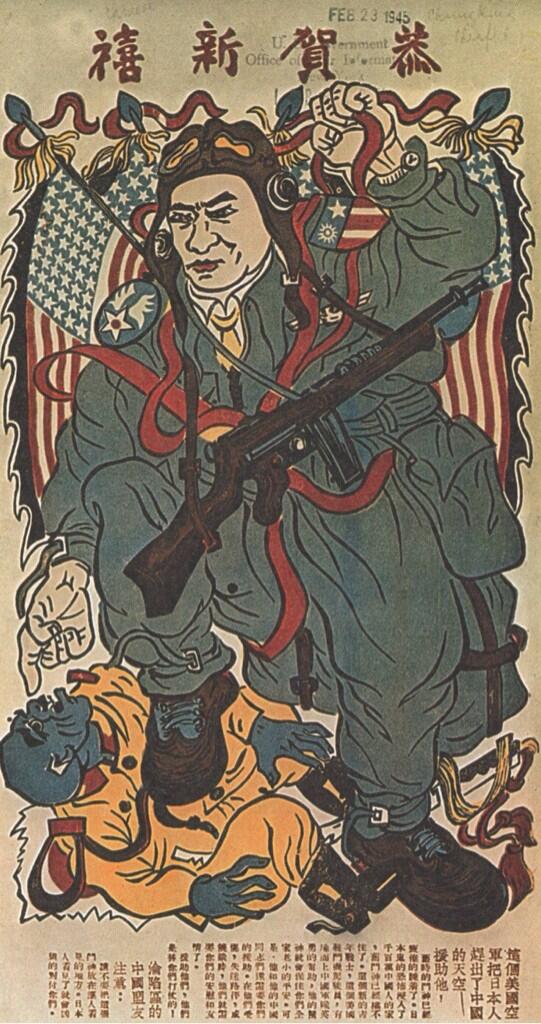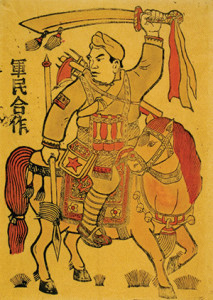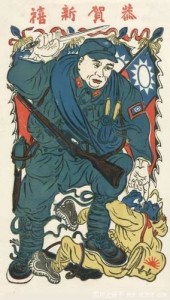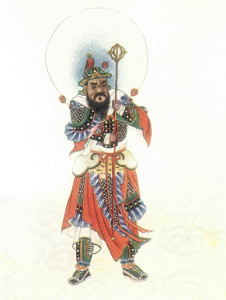Door Gods
- By Peter Harmsen
- 23 April, 2014
- No Comments
 “This American pilot is kicking the Japanese out of the skies over China. Help him.” That’s the simple message of the poster to the left. The image, showing an American aviator subduing a blue-faced, sword-wielding Japanese enemy, was part of an effort by the American military to make sure that personnel shot down over Japanese-controlled territory in China were treated as friends by the locals – which was not necessarily a foregone conclusion. Occupied China was home to significant numbers of collaborators, like every occupied country during World War 2, and the finer points of China’s friendships with western powers might be lost on illiterate farmers whose main allegiance was to the clan or the village, not to the Chinese nation as such, let alone to the nation’s faraway allies.
“This American pilot is kicking the Japanese out of the skies over China. Help him.” That’s the simple message of the poster to the left. The image, showing an American aviator subduing a blue-faced, sword-wielding Japanese enemy, was part of an effort by the American military to make sure that personnel shot down over Japanese-controlled territory in China were treated as friends by the locals – which was not necessarily a foregone conclusion. Occupied China was home to significant numbers of collaborators, like every occupied country during World War 2, and the finer points of China’s friendships with western powers might be lost on illiterate farmers whose main allegiance was to the clan or the village, not to the Chinese nation as such, let alone to the nation’s faraway allies.
What’s most interesting is the medium that the US military, or perhaps its Chinese advisors, decided to use for this particular message. It’s in the form of a poster usually reserved for the Chinese Door Gods, decorations that have traditionally been pasted at the entrance of temples and homes to ward off evil spirits. The practice can arguably be traced all the way back to the Tang Dynasty (618 to 907 A.D.) and its founding father, the Taizong emperor, who honored his two favorite generals by placing their images at the front of his palace.
Door Gods are particularly popular around Lunar New Year, which falls in either January or February, a fact alluded to in the World War 2-era poster with the four characters on top: Gonghe Xinxi, which roughly translates as “Happy New Year.” Of course, the imagery has been updated to the 20th century, complete with an M1928 Thompson submachine gun (not standard issue among US pilots, but it looks good!)
At first glance the choice of a Door God poster might come across as a too obvious and perhaps even slightly condescending attempt to communicate with the locals “in a language they understand”. However, it appears that it was an accepted part of poster art during the Second Sino-Japanese War, also employed by the Chinese propagandists themselves. Two examples of exactly that: A mounted rebel, probably communist (left), and a Nationalist soldier (right).
also employed by the Chinese propagandists themselves. Two examples of exactly that: A mounted rebel, probably communist (left), and a Nationalist soldier (right).
In traditional Chinese culture, the Door Gods would come in couples, with one placed on each side of the entrance, facing each other. It is unclear if this detail was remembered by the creator of the pilot poster. But maybe it was. It is possible that the poster to the right is the other half of a couplet that originally included the pilot. It has the same New Year greeting. And if placed the right way, they even face each other, as tradition dictates they should.




 Copyright © 2025
Copyright © 2025
Leave a Reply